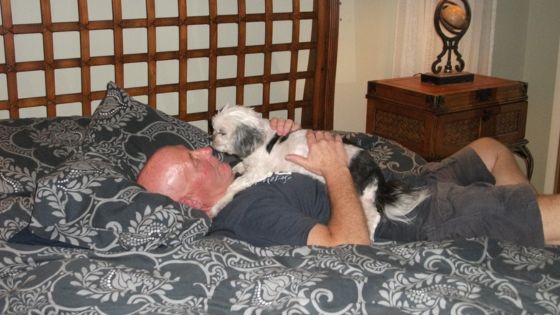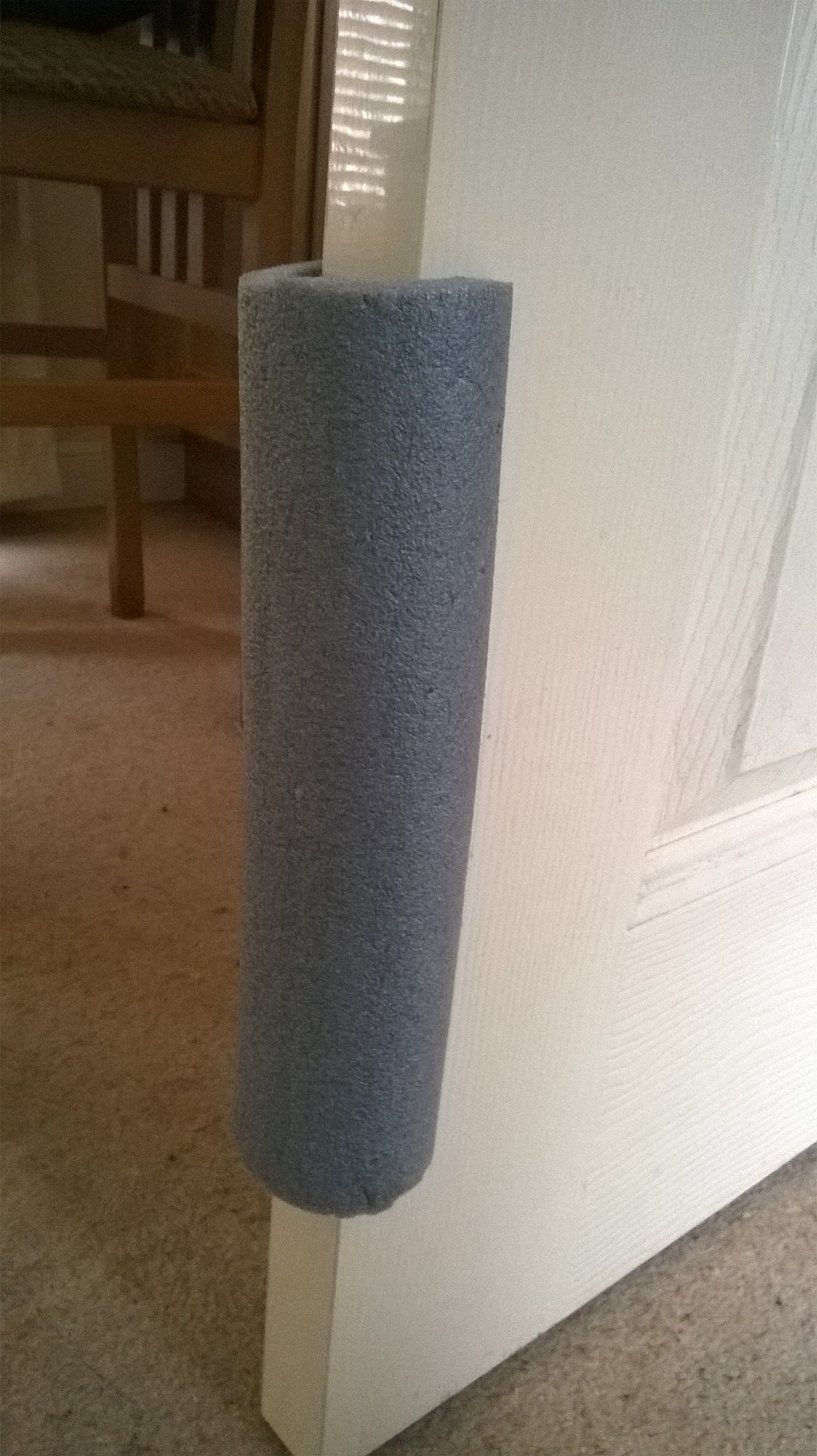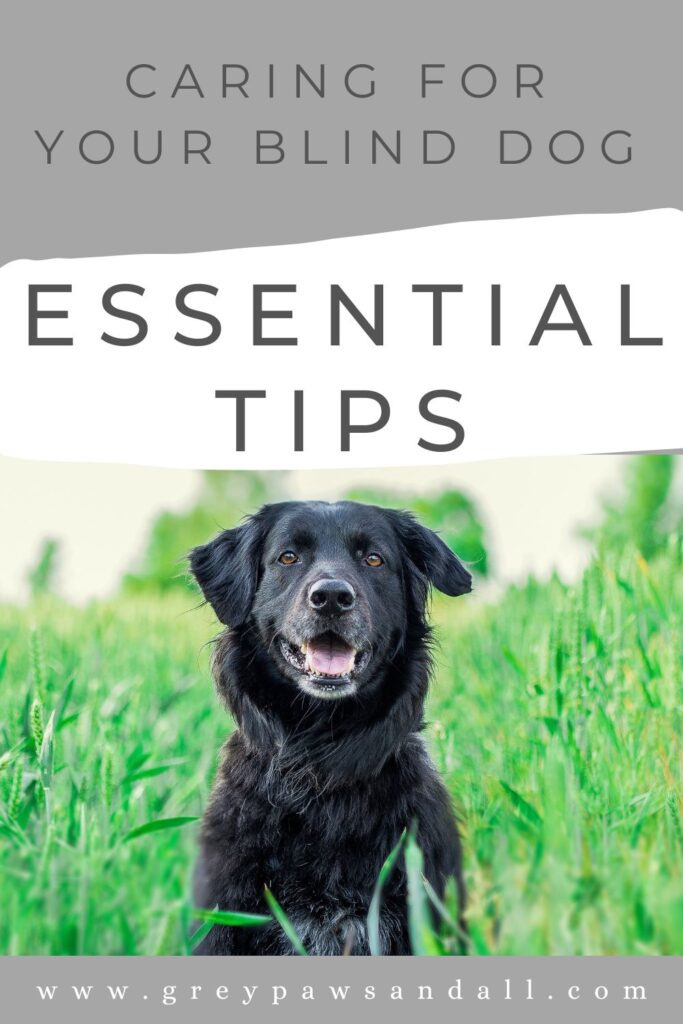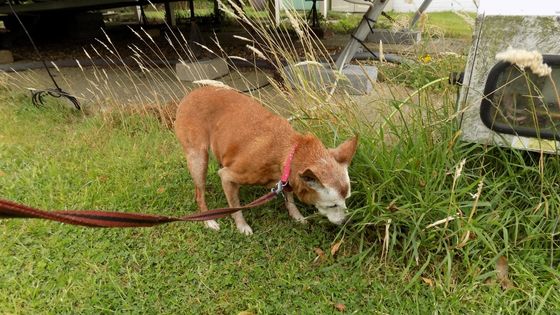I’ve shared my life with 2 blind dogs, so I’ve learned quite a few things about keeping them safe and happy.
A blind dog is first and foremost a dog, so you would care for him or her as you would one that could see, with extra attention needed to keep him safe both at home and outside. That means things like: making sure there are no toys on the floor to trip over; blocking off stairs with a baby gate; not leaving him alone on the couch; filling up holes in the garden and limiting off leash walks to fenced in areas.
If all this is fairly new, you may find it hard to believe things will get better. As you and your dog adapt to the blindness, there is no reason why your dog can’t still have a wonderful, happy and good quality life. You’ll have to make a few minor adjustments and be more aware of your surroundings, but she can still take walks, join you for family outings, travel, take boat trips and anything else you used to do.
**There are affiliate links in this post, which means if you buy something I may receive a small commission. This has no effect on the price you pay.**
Signs a Dog is Going Blind
- Walks on objects or surfaces he would normally avoid
- Rubs his face on the ground
- Eyes are bulging
- Cloudy eyes
- Stepping high – like he’s unsure when walking
- Closed eyes
- Discharge
- Bumps into walls, furniture
- Can’t catch toys you throw at him
- Tearing
- Redness
- Rubbing his eye
- Confused/disoriented
- Is startled when approached
- Having trouble finding his toys/food/water bowls
- Doesn’t want to go out at night
- Walking slower than usual
- Not interested in walking as much
- Aggressive when he never was before
What To Do If You Think Your Dog is Blind or Going Blind
Here’s an easy experiment to try at home.
Move a couple of pieces of furniture, turn off the lights, and watch how your dog gets around. Does he know where he’s going, or is he bumping into things? Now turn the lights back on and watch again. If he’s completely blind, you see the same results. If he has some vision, he’ll perform better in the light.
What’s your next move? Call your vet right away and find out the name of an eye specialist he or she trusts, and whether or not you need a referral. Your vet may be amazing, but it’s unlikely he has the experience or equipment needed to properly diagnose your dog’s condition and recommend a treatment plan.
When you call, please make sure you convey the urgency of your dog’s situation. If they say they’ll call you back later in the day, call them at least a couple of hours before they close. They need to understand precious time will be lost the longer they take to respond.
In the meantime, what about researching other specialists in your area? Find out if they require a referral, and how long you’d have to wait for an appointment. The more information you have in advance, the quicker you can get your dog seen.
Can Blindness in Dogs Be Temporary?
It depends on the reason for the blindness and extent of the damage. Only the eye specialist will be able to answer that question for you.
Do Dogs Get Depressed When They Go Blind?

Depression, anxiety and fear are emotions to be expected. The extent of your dog’s reaction can depend on whether he suddenly went blind, or it’s been happening gradually over months or years. When vision loss is more gradual, your dog has time to adapt to the changes.
We adopted Josephine when she was around 8, deaf and mostly blind. I remember the second she went blind so clearly. I had taken her to the shelter for some medication, and although she never liked the car and would whine, suddenly she started howling. I realised in that moment she had lost what little sight she had. We all had a very rough couple of weeks but eventually she did adapt.
That’s Josephine with my husband in the picture above. She loved him and found the most comfort when they were together.
Another factor that can play a part in your dog’s ability to adapt is, whether or not he already suffers from some degree of anxiety. I’ve included lots of tips below to help you help your dog adjust, but this article is filled with recommendations to help with anxiety – “22 Natural Ways to Calm Your Anxious Dog”
Is It Hard to Care for a Blind Dog?
At the beginning it’s normal to find it a bit difficult. You’ll be dealing with some heavy emotions, and there will be new challenges to tackle. You’ll have to make some adjustments, be more vigilant and help your dog cope with his or her new reality.
Don’t worry, over time things will fall into a new pattern, and you’ll continue to have a wonderful life together.
The thing that will make all the difference is finding a community of people who can relate. Not only will you have others to support you when you’re feeling alone, there will be great tips you can incorporate into your life. If you have a senior dog, my FB group Senior Dog Care Club is a fantastic resource for you. If your dog is younger, there are other groups specifically for blind dogs.
Is It Okay to Leave a Blind Dog Alone?
Yes…but you need to be sure he or she will be safe. I have compiled a lengthy list of ways to make sure that’s the case in the section below, and they apply whether you’re home or not.
Note: I wouldn’t leave a dog alone who just lost her vision if she doesn’t seem to be coping. Start with a couple of minutes and work your way up and notice the reaction.
Tips For Helping a Blind Dog Adjust and Be Safe
I lived with two blind dogs, Red and Josephine, so I’ve learned a lot about how to keep them safe and happy.
Tips

• The picture you see above is a piece of pipe insulation I cut down the middle, then put on every door, table and chair leg
• Put a baby gate at the top and bottom of stairs, and keep telling everyone who lives with you to keep them closed
• Don’t leave things on the floor that can be a trip hazard
• Don’t move furniture around. If you need to redecorate put the new furniture in the same place, or freshen things up with new pillows and accessories!
• Don’t pick your dog up when she’s sleeping, because she will get startled. If you need to wake her for some reason, call her name or stand close to her until she senses you.
• Get down on the floor and see your house from your dog’s eye level. Are there doorknobs or handles sticking out that can hurt him? Sharp edges of a coffee table? Cables he can trip over?
• Walk around your garden and fill in holes, check for sharp pieces of fencing sticking out or stuff he can trip over
• Don’t move dog beds around. When it’s time to wash them, put another bed or blanket down in that spot. If you leave it empty it will confuse your dog and she’ll lose her bearings
• When you want your dog to “come” for example, repeat that cue several times so he can follow the sound of your voice
• Don’t close doors you’ve always kept open, because that would change the layout of the house
• Stick to your normal routine
• Leave water bowls where they are, and consider adding one or two around the house so she won’t have to walk so far to get a drink
• Talk to your dog more and in a calm voice. Let her know what’s going on, when it’s time to go for a walk and when it’s time to eat. It will comfort her knowing you’re around
• If you’re concerned your dog isn’t drinking enough water, how about trying a dog fountain? The sound will make it easier for her to find it
• What happens if your dog is sleeping on the couch and you need to grab something from the other room? If you know you will be gone for a split second then run and come back, but how realistic is that? Don’t we often get side tracked? Put a chair or two next to the couch so she can’t fall off, but you still have to be quick about what you’re doing. The safest option is waiting until she’s up, or if someone else is home ask them to keep watch
• If you have small children in the house, please explain to them as best you can what’s going on, and ways they should be careful around her – i.e. don’t bother her when she’s sleeping, eating…
• If you have other pets, a small bell added to the collar will make it easier for a blind dog to know where the others are
• A drop of a dog safe essential oil (like lavender for example) on a toy you’re playing with together will help him find it easier. Sorry I’m about to state the obvious but…be sure you’re playing in a wide open area so he doesn’t bang into something
• Is the water bowl close to a drawer handle or sharp edge he could hurt himself on? If there’s no other place to move it, wrap the handle in a piece of fabric or pipe insulation
• When you’re out walking and someone you meet wants to pet your dog, let them know he’s blind so they don’t just reach over and startle him. Before someone does pet him, talk to your dog and let him know what’s going on
• If you have a small dog it’s easy to want to carry him around or help him all the time. If there’s a safety issue then of course, but otherwise you want him to learn to navigate on his own
• Put him on a leash and walk him around the house, to help him get the lay of the land
• If your dog uses a ramp, make sure it has raised sides or add some to prevent him falling off
• Rugs of different textures, or adding a couple of area rugs to bare floors will help her distinguish locations
• If your dog never wore a harness, now would be a good time to start. You don’t know how she’s going to react when she’s outside, and you don’t want to risk her getting scared and wiggling out of her collar. A harness is a safer option
• I taught my dog Red the word “careful” and it’s a very handy cue for a blind dog to know. It’s simple really – whenever Red got too close to banging into something I would say “careful” and she would switch directions. It took a bit of time for her to learn that, but she did
• Whenever I left the house, no matter for how long, I always said “I’ll be right back” or “I’ll be back soon” so Red wouldn’t wonder where I was. I know it’s exactly what you shouldn’t do if a dog has separation anxiety, but Red didn’t so it was fine
• If you’re visiting a new place, bring a favorite toy or blanket with you

How to Approach and Greet a Blind Dog
• I know it’s hard to resist petting every dog you see, but when it’s a blind dog it’s best to let them approach you.
• When getting close, make some sort of noise (not too loud of course!) so they don’t get startled.
• If you’re bringing your blind dog over to a friend’s house for a play date, let your dog off leash (as long as you’re in a safe and enclosed area) and ask your friend to keep her dog on a leash. This allows your dog the time to sniff around and back off if he’s scared.
• If you have children at home or your dog is around them at times, be sure they are gentle and approach slowly. Use the “pet” cue I talk about in the training section below, if they do want to touch him.
How to Walk a Blind Dog

Your blind dog needs as much exercise as he did before, but expect to see him a bit hesitant or nervous initially.
A standard 4’ or 5’ leash will give you better control then a flexi leash, and make it easier to guide him.
Stick to familiar areas at first, but if it’s busy pay attention to how your dog reacts. He may be comfortable walking the same route he’s done for years, or the loud noises will make him anxious. If that’s the case, go when it’s quiet or find a less travelled route. Many dogs will gain the confidence to go back to their usual walks, but not all will and that’s okay. This is a great opportunity to explore your city and find lots of new quiet areas for a dog walk. The calmer his outings are and the safer he feels, the more inclined he’ll be to want to go out.
You will need to be your dog’s guide, at least at the beginning, so be aware of your surroundings and anything that could be dangerous or cause him anxiety:
- Any dogs approaching she is or may be afraid of
- Noisy kids running up to her/near her
- Holes in the sidewalk or branches she can trip over
Letting a blind dog off a leash is a personal decision. I know many people do, but I would only be comfortable if I was in an enclosed area. For the time being, a long training lead will give him some freedom while keeping him safe. If you do end up letting him off, keep him in your sight at all times
How to Train a Blind Dog
Training a blind dog is almost the same as training one that can see, the major difference being your dog can’t see facial expressions or respond to hand signals.
• Keep cues simple, single words are best, and that’s true whether you’re training a blind dog or not.
• Use delicious treats he doesn’t usually get, and you only need small pieces.
• A clicker is a good training tool, because it provides a consistent sound that tells him a treat is coming.
• Teach your dog “step up” or “step down” when he’s getting off or onto the sidewalk. Each time your dog steps off the sidewalk say “step down” and give him a treat, and when he gets on say “step up” and treat. Practice this on every walk and he’ll get the hang of it in no time.
• Another important cue is “pet.” Each time you pet your dog use that cue and give him a treat. Practice that regularly and use that word whenever you or someone wants to pet him so he knows what to expect.
• I mentioned this above but it’s worth repeating. I taught my dog Red the word “careful” and it’s a very handy cue for a blind dog to know. It’s simple really – whenever Red got too close to banging into something I would say “careful” and she would switch directions. It took a bit of time for her to learn that, but she did.
How to Groom a Blind Dog
What do you do when your dog used to be fine at the groomer, but now is too stressed?
• Sometimes it may be a case of finding a different groomer. That’s not to say yours isn’t still fantastic, but there are groomers who either specialize or have more experience with blind dogs. I know how hard it is to find someone you like and trust, so if you’d rather stay where you are, have a chat about ways you can make the experience better.
• Ask your groomer if she (or he) can play dog calming music. Youtube has a huge selection so try some at home. When you find one your dog relaxes to, ask your groomer to play the same one. My favorite is called Through a Dog’s Ear.
• Instead of one long grooming session, break it down into two or more.
• Focus on the priorities! How about giving your dog a bath, and leaving it to the pros to trim your dog’s nails and the fur around his face?
• Ask your groomer to put a non slip mat on the table to help your dog feel more secure
• You never stayed with him before, but maybe the sound of your voice will relax him
• If your groomer puts your dog in a cage until you pick him up, arrive early so that doesn’t have to happen
• I don’t know how much your groomer talks to your dog, but speaking to him in a calm and soft voice may reassure him
• The sound of the dryer may now scare your dog, so speak to your groomer about alternatives. Maybe you can take him home before he’s totally dry, and wrap him in towels for the car ride
• Your dog may feel more comfortable if your groomer has a hand on him at all times, not just when washing or clipping him
• Lying down on the table instead of standing up can make a big difference
• A calming aid such as Valerian, Rescue Remedy or calming chews could help
• A few blind dog parents I know switched to a mobile groomer. They found it less stressful since there was no car ride involved and the process was faster
• If none of this is making a difference, try your best to do it yourself. Buy scissors or clippers and do a tiny patch over the course of several days. What matters most is keeping your dog clean and comfortable, even if it’s at the expense of a perfect haircut!!
My experience
I’ve shared my life with two blind dogs, Red and Josephine. Red’s hair didn’t grow so the only thing I ever had to worry about were baths and nails. Thankfully she was quite easy going about the bath, which my husband was responsible for. She was small enough to fit into the sink and I would dry her with towels. It was a nice bonding session and she loved it.
The groomer would do her nails and I don’t think it ever took more than a minute, two at the most. She was not a fan of anyone touching her paws so it was a two person job, and we needed to do it quickly. Because she was older and her quicks were very long, it was only possible to cut off the tips so she had to go more often than other dogs. Not her favorite thing in the world, but she was good natured and had been blind for a long time before we got her, so she was fine.
Josephine was another story. She was a Shih Tzu who was blind and deaf and would absolutely freak out. I called more groomers than I can remember, and as soon as I said I had a blind dog they told me they couldn’t do it. Better to be honest up front then to put her through a horrible experience, but I was still surprized.
Since trimming the hair around her face and eyes was crucial, as was having her nails cut, we took her to the vet where they had to sedate her with a mask. We were so desperate we saw no other option, but after the second time we never did it again. It was too traumatic for her and us.
My husband was in charge of the baths, and I was in charge of the hard part!! I bought a shaver and we would set up 5 minute grooming sessions. We both sat on the floor, he fed her pieces of chicken in a steady stream, while I trimmed her face and eyes and ran the shaver quickly over her body. I wasn’t going to win any hairdressing competitions, but at least she was calmer and that’s all that mattered.
Products For Blind Dogs
Muffin’s Halo – designed to prevent dogs from bumping into things. I’ve never used it because it would have annoyed my dogs, but it’s worth looking into
Doggles (goggles for dogs) – protect your dog’s eyes from low hanging branches and debris when on a walk
Toys – make sure she always has access to the toys she’s always loved, but you may want to try some new ones. What about those that make noise, talk, have a scent, different textures or dispense treats.
Snuffle mat – let your dog practice his natural foraging skills to find those delicious treats hidden inside.
A collar, harness and/or leash with the words blind dog on it is a good way for others to be aware so they don’t approach him suddenly.
Dog stroller – I’m recommending a dog stroller not because a blind dog can’t walk as far or as fast as he or she used to be, but because it made a huge difference in our lives. In high traffic areas when the commotion gets overwhelming, the dog stroller will keep her safe and help her feel secure. It means she’ll be able to join you on more outings.
What tips have you found to help your blind dog feel safe? Sharing helps others, so leave them in the comments section below.
If you’re looking for a community of senior dog parents, a place where you can find helpful tips, support and people who “get it” please join my FB group Senior Dog Care Club
I help senior dog parents struggling with anticipatory grief and quality of life issues by offering practical tips, advice and one on one support.
I am also a Certified Pet Loss Specialist, helping you navigate through your pet loss journey.
Click this link to book a FREE 20 minute discovery call, visit my service page to find out more or email hindy@greypawsandall.com if you have any questions.
I’ve been rescuing and caring for senior dogs since 2009. From vision and hearing loss to obesity, dementia, kidney disease, liver issues, cardiac problems, Cushing’s, mobility challenges and more, you could say I’ve dealt with and learned a lot! In addition to my hands on experience, I’ve taken many courses and earned several qualifications to keep learning how to help senior dogs and they include: Senior Dog Enrichment, Understanding Canine Anxiety, Care of the Senior Pet and I’m a Certified Pet Loss Specialist.

